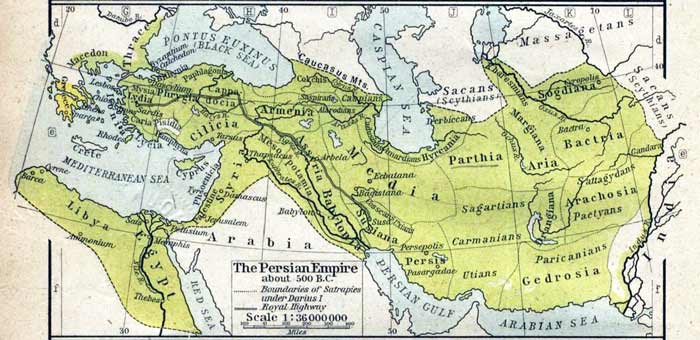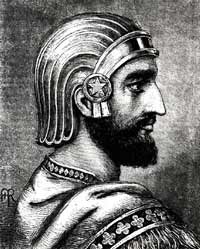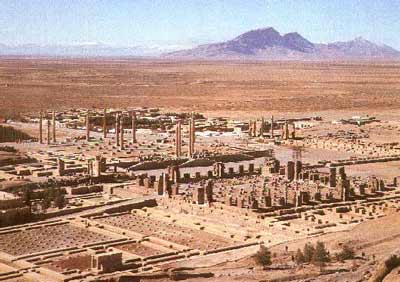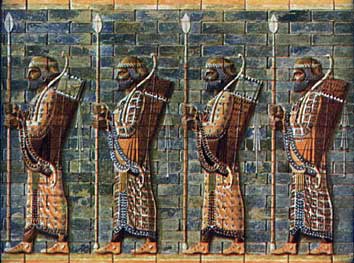
The Persian Empire in 500 BCE
Neil Faulkner Archive | ETOL Main Page
Marxist History
Published online by Counterfire, 31 August 2010.
Copied with thanks from the Counterfire Website.
Marked up by Einde O’Callaghan for the Encyclopaedia of Trotskyism On-Line (ETOL).
Neil Faulkner looks at the centuries following 1000 BCE when the scale of civilisation and empire exploded as the productivity of iron tools boosted the surpluses available to Iron Age empire-builders.

The Persian Empire in 500 BCE |
Bronze Age empires were small and separate. They were based on the great alluvial flood-plains of the Nile in Egypt, the Tigris and Euphrates in Iraq, the Indus in Pakistan, and the Yellow in northern China. Vast tracts of desert, steppe-land, and mountain lay between these early centres of civilisation.
With tools of wood and stone, productivity was low and surpluses small. Using Bronze Age technology, only the extraordinary fertility of the great river valleys yielded sufficient wealth to build cities, sustain armies, and create empires.
Even in the Late Bronze Age, sites like Knossos (in Crete), Mycenae (in Greece), and Troy (in north-western Turkey) represented a relatively underdeveloped periphery. They were palaces or citadels of modest size and monumentality. The wealth of Minoan merchant-princes and Mycenaean warlords did not compare with that of New Kingdom pharaohs.
This changed in the centuries following 1000 BCE (before the common era): the scale of civilisation and empire exploded. Iron Age farmers hacked fields out of the wilderness and ploughed the heavy soils they found there. Productivity and population soared. The surpluses available to Iron Age empire-builders dwarfed those of their Bronze Age predecessors.
At the end of the 3rd century BCE, China was united by the Ch’in warlord Shih Huang-ti. He ruled a territory five times larger than that of the Shang Dynasty of the Late Bronze Age.
A century before, in the late 4th century BCE, the Mauryan warlord Chandragupta had founded the first Indian empire. Reaching its peak a century later, the Mauryan Empire eventually encompassed much of the Indus Valley, the whole of the Northern Plain, and also the Ganges Valley, Nepal, and a large part of the Deccan.

Cyrus the Great |
Some two centuries earlier still, in the mid to late 6th century BCE, three great Persian conquerors, Cyrus, Cambyses, and Darius, had built an empire of even greater extent. At its peak, around 500 BCE, it stretched from Thrace (Bulgaria) in the west to the Indus (Pakistan) in the east, and from the Caucasus Mountains in the north to the Nubian Desert in the south.
The Persians were settled farmers of the rugged mountain valleys in south-western Iran. The Medes were nomadic horsemen of the great steppe-land in north-eastern Iran. In 550 BCE, Persia and Media were united by conquest. Within two generations, Iraq, Egypt, Turkey, Pakistan, and Afghanistan had been added to the empire.
The Persian Empire of the 6th century BCE therefore encompassed three of the four original centres of civilisation – the Nile, the Tigris-Euphrates, and the Indus river-valleys. These and the territories between were integrated into a single imperial polity and ruled as a patchwork of tribute-bearing provinces.
There was no attempt to weld the provinces of the empire into a unified cultural whole. The Persian emperor was styled the ‘Great King’ – he was ruler over a series of distinct subject-peoples who retained their own ethnic and religious identities, their own economic and social organisation, and their own political structures.
Stone relief-sculptures decorate the ceremonial stairway leading to the principal audience-hall of the imperial palace at Persepolis. They depict delegations from 23 separate subject-peoples bringing gifts or tribute to the Great King, including clothing, metal vessels, gold, elephant tusks, horses and camels, and such exotic animals as antelope, lions, and okapi.

The Persian imperial capital at Persepolis |
Building inscriptions at Persepolis list the principal peoples of the empire, while thousands of inscribed clay-tablets record disbursements of food or silver to royalty, officials, and workmen.
How was the collection of tribute from such a vast area enforced? The empire was divided into large provinces ruled by viceroys (called ‘satraps’). A network of roads and an official post system linked the satraps with the imperial capital. The Royal Road, for example, ran from the provincial capital at Sardis in western Turkey to the imperial capital at Susa in western Iran.
Satraps controlled large armies and fleets. But in the event of a major rebellion or foreign expedition, a grand army would be formed under the leadership of the Great King. Its composition would reflect the polyglot character of the empire: each separate ethnic component would fight in its own manner.
The wealth of the Great King is evident from the size of the royal palaces at Persepolis, Susa, Hamadan, Pasargadae, and Babylon. Persepolis was a vast complex of audience halls, reception rooms, royal residences, storerooms for tribute, barracks for imperial guards, a walled hunting park, a huge ornamental lack, and a sprawling town of artisans, traders, and labourers.
When Alexander the Great captured Persepolis in 331 BCE, it contained treasure equal in value to the annual income of Athens, richest of the Greek cities, for 300 years.

The Persian imperial guard |
Despite its wealth, the Persian Empire was relatively unstable and short-lived. Cyrus had created a powerful instrument of conquest when he united the Persians and the Medes. The Persians fought as infantry with spears and bows. The Medes were first-class light cavalry. The resulting combination of mobility, firepower, and shock action produced a whirlwind of conquest.
But military supremacy does not equate to either political hegemony or social transformation. The Persians merely incorporated existing ruling classes and appropriated part of their surplus. Their empire lacked all cohesion save that imposed by force.
The vastness and diversity of the empire weakened the centre. Native kings and provincial satraps wielded immense power. Rebellion was endemic, especially on the more remote frontiers.
The Persia empire was an attempt to cement together geopolitically separate and culturally alien entities – Turkey, Egypt, Iraq, Iran, Afghanistan, and Pakistan. Because of this, its natural tendency was to disintegrate rather than cohere.
It was an external force, however, that shattered the fragile carapace. As it reached its fullest extent in the late 6th century BCE, the Persian Empire collided with another civilisation on its furthest north-western fringes. This collision pitted the wealth of the greatest empire the world had ever seen against small communities of peasant-farmers.
It tested to the limit two entirely different social and political orders. Both were products of the Iron Age. But while one was simply a replication of ancient imperialism on a global scale, the other was a new social order created in the storm and strife of revolution. It was in the tiny city-states of Ancient Greece that the Iron Age transformation achieved its most advanced social form.
Before turning to it, however, we must chart the course of civilisation in India and China.
Neil Faulkner Archive | ETOL Main Page
Eleven Reasons to Fight
Last updated on: 13 February 2022